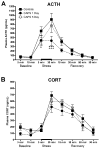Effects of chronic plus acute prolonged stress on measures of coping style, anxiety, and evoked HPA-axis reactivity
- PMID: 22842072
- PMCID: PMC3427462
- DOI: 10.1016/j.neuropharm.2012.07.034
Effects of chronic plus acute prolonged stress on measures of coping style, anxiety, and evoked HPA-axis reactivity
Abstract
Exposure to psychological trauma is the precipitating factor for PTSD. In addition, a history of chronic or traumatic stress exposure is a predisposing risk factor. We have developed a Chronic plus Acute Prolonged Stress (CAPS) treatment for rats that models some of the characteristics of stressful events that can lead to PTSD in humans. We have previously shown that CAPS enhances acute fear responses and impairs extinction of conditioned fear. Further, CAPS reduced the expression of glucocorticoid receptors in the medial prefrontal cortex. In this study we examined the effects of CAPS exposure on behavioral stress coping style, anxiety-like behaviors, and acute stress reactivity of the hypothalamic-pituitary-adrenal (HPA) axis. Male Sprague-Dawley rats were exposed to CAPS treatment, consisting of chronic intermittent cold stress (4 °C, 6 h/day, 14 days) followed on day 15 by a single 1-h session of sequential acute stressors (social defeat, immobilization, swim). After CAPS or control treatment, different groups were tested for shock probe defensive burying, novelty suppressed feeding, or evoked activation of adrenocorticotropic hormone (ACTH) and corticosterone release by an acute immobilization stress. CAPS resulted in a decrease in active burying behavior and an increase in immobility in the shock probe test. Further, CAPS-treated rats displayed increases in the latency to feed in the novelty suppressed feeding test, despite an increase in food intake in the home cage. CAPS treatment also reduced the HPA response to a subsequent acute immobilization stress. These results further validate CAPS treatment as a rat model of relevance to PTSD, and together with results reported previously, suggest that CAPS impairs fear extinction, shifts coping behavior from an active to a more passive strategy, increases anxiety, and alters HPA reactivity, resembling many aspects of human PTSD.
Copyright © 2012 Elsevier Ltd. All rights reserved.
Figures




Similar articles
-
Prenatal stress induces long term stress vulnerability, compromising stress response systems in the brain and impairing extinction of conditioned fear after adult stress.Neuroscience. 2011 Sep 29;192:438-51. doi: 10.1016/j.neuroscience.2011.06.041. Epub 2011 Jun 22. Neuroscience. 2011. PMID: 21723377
-
A single exposure to immobilization causes long-lasting pituitary-adrenal and behavioral sensitization to mild stressors.Horm Behav. 2008 Nov;54(5):654-61. doi: 10.1016/j.yhbeh.2008.07.003. Epub 2008 Jul 16. Horm Behav. 2008. PMID: 18675818
-
Prefrontal-Bed Nucleus Circuit Modulation of a Passive Coping Response Set.J Neurosci. 2019 Feb 20;39(8):1405-1419. doi: 10.1523/JNEUROSCI.1421-18.2018. Epub 2018 Dec 20. J Neurosci. 2019. PMID: 30573644 Free PMC article.
-
Role of brain norepinephrine in the behavioral response to stress.Prog Neuropsychopharmacol Biol Psychiatry. 2005 Dec;29(8):1214-24. doi: 10.1016/j.pnpbp.2005.08.007. Epub 2005 Oct 13. Prog Neuropsychopharmacol Biol Psychiatry. 2005. PMID: 16226365 Review.
-
The Role of Early Life Stress in HPA Axis and Anxiety.Adv Exp Med Biol. 2020;1191:141-153. doi: 10.1007/978-981-32-9705-0_9. Adv Exp Med Biol. 2020. PMID: 32002927 Review.
Cited by
-
High rates of mood disorders in patients with chronic idiopathic eosinopenia.Brain Behav Immun Health. 2024 Aug 12;40:100847. doi: 10.1016/j.bbih.2024.100847. eCollection 2024 Oct. Brain Behav Immun Health. 2024. PMID: 39252984 Free PMC article.
-
Juvenile Exposure to BPA Alters the Estrous Cycle and Differentially Increases Anxiety-like Behavior and Brain Gene Expression in Adult Male and Female Rats.Toxics. 2022 Aug 30;10(9):513. doi: 10.3390/toxics10090513. Toxics. 2022. PMID: 36136478 Free PMC article.
-
Role of TrkB in the anxiolytic-like and antidepressant-like effects of vagal nerve stimulation: Comparison with desipramine.Neuroscience. 2016 May 13;322:273-86. doi: 10.1016/j.neuroscience.2016.02.024. Epub 2016 Feb 16. Neuroscience. 2016. PMID: 26899129 Free PMC article.
-
Rat Models in Post-Traumatic Stress Disorder Research: Strengths, Limitations, and Implications for Translational Studies.Pathophysiology. 2024 Dec 6;31(4):709-760. doi: 10.3390/pathophysiology31040051. Pathophysiology. 2024. PMID: 39728686 Free PMC article. Review.
-
Chronic stress and lack of social support: Role in adolescent depression and suicide-related behaviors in the context of the COVID-19 pandemic.J Affect Disord. 2024 Nov 15;365:437-442. doi: 10.1016/j.jad.2024.08.090. Epub 2024 Aug 17. J Affect Disord. 2024. PMID: 39159787
References
-
- American Psychiatric Association. Diagnostic and Statistical Manual of Mental Disorders. 4. American Psychiatric Association; Washington, D.C: 2000. text rev.
-
- Blanchard RJ, Nikulina JN, Sakai RR, McKittrick C, McEwen B, Blanchard DC. Behavioral and endocrine change following chronic predatory stress. Physiol Behav. 1998;63:561–569. - PubMed
-
- Blechert J, Michael T, Vriends N, Margraf J, Wilhelm FH. Fear conditioning in posttraumatic stress disorder: evidence for delayed extinction of autonomic, experiential, and behavioral responses. Behav Res Ther. 2007;45:2019–2033. - PubMed
Publication types
MeSH terms
Substances
Grants and funding
LinkOut - more resources
Full Text Sources
Medical
Miscellaneous

